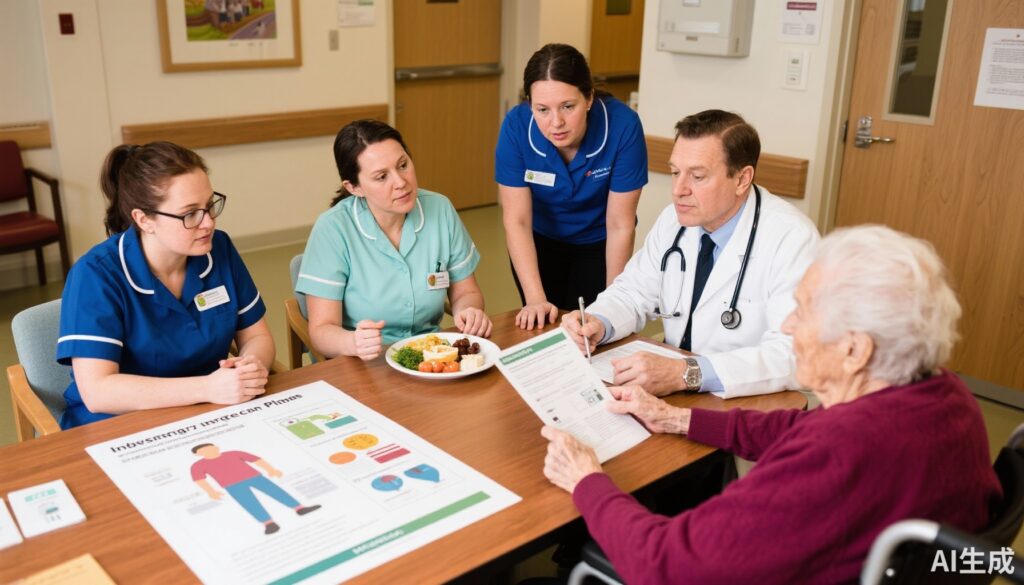Introduction and Context
Falls among older people living in care facilities are a major source of illness, loss of independence, fractures and death worldwide. In August 2025 a major update of the Cochrane systematic review—”Interventions for preventing falls in older people in care facilities” (Dyer et al., 2025)—pooled randomized trial evidence from 104 trials involving nearly 69,000 residents and clarified which strategies reduce falls in this setting. This update separates care-facility evidence from hospital evidence and adds 33 trials since the prior update, changing the confidence in several interventions.
Why this review matters now: care homes face rising resident complexity (cognitive impairment, multimorbidity, polypharmacy), workforce pressures and constrained resources. Decision-makers need clear guidance on which fall-prevention strategies are effective, for whom they work best, and whether they are likely to be cost-effective.
Key complementary guidance includes the WHO global report on falls prevention (2007), the American Geriatrics Society/British Geriatrics Society practice statements (AGS/BGS, 2011), and national programmes such as CDC’s STEADI. The Cochrane 2025 review provides the most up-to-date randomized-trial synthesis specifically for care facilities and assigns certainty ratings to findings to guide implementation.
New Guideline Highlights (Major Findings)
– Multifactorial interventions that are tailored to the individual and implemented with active facility staff engagement probably reduce both the rate of falls and the number of residents who fall (moderate-certainty evidence). When delivered in a tailored, staff-engaged way these interventions may produce large reductions in fall rates.
– Active exercise programs (balance and functional training delivered as structured activity) probably reduce fall rates and the risk of falling while the intervention is ongoing (moderate-certainty evidence). Benefits disappear if exercise is not sustained after the intervention ends.
– Medication optimisation strategies as a single intervention probably make little or no difference to fall outcomes overall (moderate- to low-certainty evidence); evidence on targeted deprescribing is very uncertain.
– Vitamin D supplementation probably reduces fall rate in trials where participants had low vitamin D levels (moderate-certainty evidence) but does not clearly reduce the number of people who fall.
– Nutritional intervention in the form of increasing dairy servings (protein and calcium) via dietitian-led menu changes showed reductions in falls and fractures in one large trial (low-certainty evidence).
– Evidence on adverse events and long-term cost-effectiveness remains limited and varied.
Quick clinical takeaways
– Prioritise multifactorial, tailored programmes that actively engage facility staff and address environmental, mobility, medication and nutritional risks.
– Implement or maintain ongoing exercise programmes (balance/functional training) rather than time-limited campaigns.
– Use medication review as part of a multifactorial approach; isolated deprescribing interventions have uncertain impact on falls.
– Consider vitamin D supplementation for residents with documented deficiency or low levels; routine universal supplementation solely to prevent falls is less clearly supported.
Updated Recommendations and Key Changes from Prior Guidance
The 2025 Cochrane update differs from earlier reviews by:
– Isolating care-facility evidence from hospital settings so facility-specific conclusions are clearer.
– Adding many large cluster-randomized trials (33 new trials; 27,492 participants) that increase confidence in tailored multifactorial approaches and exercise programmes.
– Using subgroup and qualitative comparative analyses to show that staff engagement and tailoring to resident circumstances (for example, dementia) materially change effectiveness.
– Clarifying that exercise benefits are time-limited unless activity is sustained, a nuance that older reviews signaled but could not quantify.
How this changes practice compared with prior guidance
– Earlier guidance recommended multifactorial assessment and targeted interventions; the Cochrane 2025 update strengthens that recommendation but specifies that the delivery model matters: facility staff engagement and tailoring amplify benefit.
– Vitamin D recommendations become more conditional: benefit is most apparent where baseline vitamin D is low.
– Medication review alone should not be expected, with high confidence, to substantially reduce falls—clinicians should integrate deprescribing into broader programmes and measure outcomes.
Topic-by-Topic Recommendations
Below are practical, evidence-based recommendations summarised from the review. Each recommendation includes the Cochrane-rated certainty of evidence (high, moderate, low, very low) as stated in the review.
Multifactorial interventions (assessment + tailored actions)
– Recommendation: Offer a multifactorial fall-risk assessment followed by individually tailored interventions that address identified risks (e.g., exercise, assistive devices, medication review, environmental modification, vision, and continence management), and implement these with active facility staff engagement. (Moderate-certainty evidence: probably reduces fall rate and risk of falling.)
– Delivery features linked to greater effect: explicit tailoring to resident circumstances (including dementia), involvement and training of front-line staff to lead implementation, and inclusion of exercise and medication optimisation within the package.
Exercise (single intervention)
– Recommendation: Provide structured, active exercise programs focusing on balance, strength, and functional tasks for residents able to participate; ensure programmes are ongoing rather than time-limited. (Moderate-certainty evidence: probably reduces fall rate and risk of falling while active; high-certainty evidence that effects are not sustained if exercise ceases.)
– Cognitive impairment: Active exercise may reduce fall risk even among residents with cognitive impairment (low-certainty evidence); adapt delivery (shorter sessions, supervised group or individual sessions).
Medication optimisation / review / deprescribing
– Recommendation: Conduct regular medication reviews for residents at risk of falls, focusing on psychotropic, sedative, and medications affecting orthostatic blood pressure; incorporate medication optimisation within a multifactorial programme rather than as a sole intervention. (Moderate- to low-certainty evidence: overall little or no effect when used alone; deprescribing evidence is very uncertain.)
– Use recognised tools (e.g., STOPP/START criteria) to identify potentially inappropriate medications (see references). Medication changes should be clinically supervised with monitoring.
Vitamin D (with or without calcium)
– Recommendation: Consider vitamin D supplementation for care home residents who are deficient or likely to be deficient (limited sunlight exposure, frail, institutionalized). Trials with low baseline vitamin D show reduced fall rate, but evidence is mixed for reduction in number of people who fall. (Moderate-certainty evidence for rate reduction in deficient populations.)
Nutrition: dietary protein and calcium
– Recommendation: Integrate dietitian-led nutritional strategies to ensure adequate protein and calcium intake; one trial found that increasing dairy servings through menu redesign reduced falls and fractures (low-certainty evidence). Consider this as part of a multifactorial package, especially for undernourished residents.
Environmental modifications and assistive devices
– Recommendation: Assess and address environmental hazards (flooring, lighting, furniture layout), and ensure appropriate assistive devices are available and properly used. This is standard practice within multifactorial programmes; randomized evidence is usually incorporated into multifactorial packages rather than isolated device-only trials.
Risk stratification, monitoring, and follow-up
– Recommendation: Implement regular fall recording, ongoing risk reassessment after falls, and audit of intervention fidelity. Sustained delivery and monitoring are essential—exercise and many multifactorial benefits wane when programmes end.
Adverse events and cost-effectiveness
– Adverse events were poorly reported across trials; clinicians should monitor for exercise-related injuries, orthostatic symptoms after deprescribing, and potential harms of vitamin D for hypercalcemia (rare).
– Cost-effectiveness evidence is limited but suggests some multifactorial programmes and exercise interventions may be cost-effective in select settings; local modelling recommended.
Expert Commentary and Insights
What the guideline committee and reviewers emphasized
– Implementation matters: trial-level variation in results is driven less by the choice of individual components and more by how programmes are delivered—especially whether facility staff are trained and engaged to own and adapt interventions.
– Tailoring is key: residents in care homes are heterogeneous; a one-size-fits-all package is less effective than individualised care-planning that accounts for dementia, mobility, frailty and personal goals.
Areas of consensus
– Multifactorial, resident-centred approaches should be the foundation of fall prevention in care homes.
– Sustained, feasible exercise programmes are beneficial and should be prioritized where residents can participate.
Ongoing controversies and research gaps
– The role of medication review as a stand-alone fall-prevention strategy remains controversial; high-quality trials of structured deprescribing with fall outcomes are needed.
– Vitamin D: whether universal supplementation is justified for fall prevention remains debated; benefit appears strongest in deficient populations.
– Implementation research: which workforce models, training packages, and quality-improvement strategies best translate trial efficacy into routine care requires more study.
Practical Implications for Care Homes and Clinicians
At the facility level
– Adopt a fall-risk assessment protocol on admission and after any fall that feeds into an individualised care plan.
– Build a small multidisciplinary falls team (nurse lead, physiotherapist/OT, pharmacist, dietitian) that coaches frontline staff and audits outcomes.
– Prioritise sustainable exercise offerings (group balance classes, chair-based strength work adapted for frailty) with routine scheduling and documentation.
Clinical workflow examples
– Medication review: use STOPP/START criteria (O’Mahony 2015) to flag high-risk medications and combine deprescribing trials with monitoring and non-pharmacologic alternatives.
– Nutrition: work with dietitians to audit protein/calorie intake and adjust menus; one large trial showed benefit from dietitian-led increases in dairy servings.
Implementation checklist (practical steps)
– Baseline fall audit and staff training plan
– Standardised assessment tool for falls risk
– Individualised care plan template with measurable goals
– Scheduled, supervised exercise programme with participation targets
– Regular medication reviews integrated into the care plan
– Nutritional screening and dietitian input where indicated
– Ongoing data collection on falls, fractures and adverse events
Illustrative Patient Vignette
Mrs. Joan Carter, an 85‑year‑old care-home resident with mild dementia and recent urinary incontinence, had two falls in three months. Using the 2025 evidence-based approach the home’s falls team:
– Completed a multifactorial assessment (mobility, footwear, medication list, vision, environment).
– Introduced a tailored plan: supervised balance and strength sessions three times weekly, a medication review that reduced nighttime sedative dose, improved lighting and uncluttered pathways near her room, and dietitian-led snacks to increase protein.
– After six months Mrs. Carter had no further falls and reported improved confidence when walking. The team continued the exercise programme and monitored her meds and nutrition.
This vignette exemplifies the key messages: tailor interventions to the resident and engage staff to deliver sustained programmes.
References
1. Dyer SM, Kwok WS, Suen J, et al. Interventions for preventing falls in older people in care facilities. Cochrane Database Syst Rev. 2025 Aug 20;8(8):CD016064. doi:10.1002/14651858.CD016064.
2. World Health Organization. WHO Global Report on Falls Prevention in Older Age. Geneva: WHO; 2007. https://www.who.int/ageing/publications/Falls_prevention7March.pdf
3. Panel on Prevention of Falls in Older Persons; American Geriatrics Society and British Geriatrics Society. Summary of the Updated American Geriatrics Society/British Geriatrics Society Clinical Practice Guideline for Prevention of Falls in Older Persons. J Am Geriatr Soc. 2011;59(1):148–157.
4. National Institute for Health and Care Excellence (NICE). Falls in older people: assessing risk and prevention. Clinical guideline [CG161]. London: NICE; 2013. https://www.nice.org.uk/guidance/cg161
5. Centers for Disease Control and Prevention. STEADI — Older Adult Fall Prevention. CDC. Updated resources and clinical toolkit. https://www.cdc.gov/steadi/index.html
6. O’Mahony D, O’Sullivan D, Byrne S, et al. STOPP/START criteria for potentially inappropriate prescribing in older people: version 2. Age Ageing. 2015;44(2):213–218. doi:10.1093/ageing/afu145
Final note
The Cochrane 2025 review gives care facilities clearer, higher-certainty evidence than previously available that tailored multifactorial programmes with staff engagement and sustained exercise are effective ways to reduce falls. Facility leaders and clinicians should prioritise implementation of these strategies while recognizing gaps—particularly around deprescribing and long-term cost-effectiveness—that future research must address.



